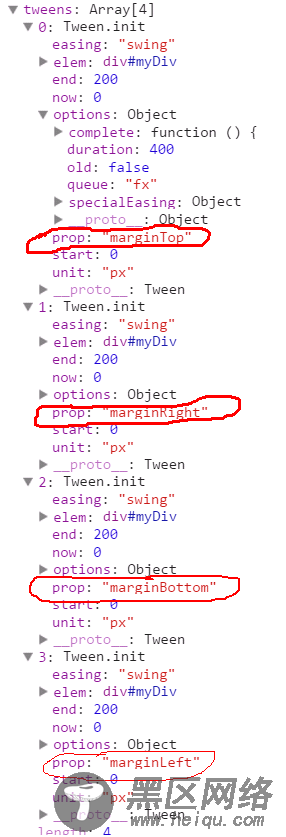在jQuery内部函数Animation中调用到了createTweens()来创建缓动动画组,创建完成后的结果为:

可以看到上面的缓动动画组有四个原子动画组成。每一个原子动画的信息都包含在里面了。
仔细查看createTweens函数,实际上就是遍历调用了tweeners ["*"]的数组中的函数(实际上就只有一个元素)。
function createTweens( animation, props ) { jQuery.each( props, function( prop, value ) { var collection = ( tweeners[ prop ] || [] ).concat( tweeners[ "*" ] ), index = 0, length = collection.length; for ( ; index < length; index++ ) { if ( collection[ index ].call( animation, prop, value ) ) { // we're done with this property return; } } }); }
再次查看这个tweeners ["*"][0]函数,主要代码如下
function( prop, value ) { var end, unit, //根据css特征值获取缓动动画结构 tween = this.createTween( prop, value ), parts = rfxnum.exec( value ), target = tween.cur(), start = +target || 0, scale = 1, maxIterations = 20; if ( parts ) { end = +parts[2]; unit = parts[3] || ( jQuery.cssNumber[ prop ] ? "" : "px" ); //非像素单位的属性 if ( unit !== "px" && start ) { // 从一个非零起点开始迭代, //对于当前属性,如果它使用相同的单位这一过程将是微不足道 // 后备为end,或一个简单的常量 start = jQuery.css( tween.elem, prop, true ) || end || 1; do { //如果前一次迭代为零,加倍,直到我们得到*东西* //使用字符串倍增因子,所以我们不会偶然看到scale不改变 scale = scale || ".5"; // 调整和运行 start = start / scale; jQuery.style( tween.elem, prop, start + unit ); // 更新scale, 默认0或NaN从tween.cur()获取 // 跳出循环,如果scale不变或完成时, 或者我们已经觉得已经足够了 } while ( scale !== (scale = tween.cur() / target) && scale !== 1 && --maxIterations ); } tween.unit = unit; tween.start = start; //如果提供了+=https://www.jb51.net/-=记号,表示我们正在做一个相对的动画 tween.end = parts[1] ? start + ( parts[1] + 1 ) * end : end; } return tween; }] };
可以看出除了hide/show两种动画外的其他动画都经过tweeners ["*"][0]这个函数封装了动画组。其中有几个关键的数组start/end/unit。特别是对非像素单位的动画start值获取费了一番功夫。
还有一个比较关键的地方是都用了this.createTween获取单个css特征的基础的动画特征。而animation. createTween中直接调用jQuery.Tween来处理。接下来我们详解之。
a.jQuery.Tween
--------------------------------------------------------------------------------
jQuery.Tween的结构和jQuery类似
function Tween( elem, options, prop, end, easing ) { return new Tween.prototype.init( elem, options, prop, end, easing ); } jQuery.Tween = Tween; Tween.prototype = { constructor: Tween, init: function( elem, options, prop, end, easing, unit ) { this.elem = elem; this.prop = prop; this.easing = easing || "swing"; this.options = options; this.start = this.now = this.cur(); this.end = end; this.unit = unit || ( jQuery.cssNumber[ prop ] ? "" : "px" ); }, cur: function() {...}, run: function( percent ) {...} }; Tween.prototype.init.prototype = Tween.prototype;
是不是有一种很熟悉的赶脚。
里面cur函数用来获取当前的css特征值
cur: function() { var hooks = Tween.propHooks[ this.prop ]; return hooks && hooks.get ? hooks.get( this ) : Tween.propHooks._default.get( this ); },
而run函数则会在每个动画时间点上对正在进行的动画的每个特征值进行处理。
主要是两个步骤:
1.计算动画当前进度pos和动画当前位置now
//如果有动画时长则使用jQuery.easing计算出缓动动画进度eased,否则进度eased为percent //并根据进度得到当前动画位置now if ( this.options.duration ) { this.pos = eased = jQuery.easing[ this.easing ]( percent, this.options.duration * percent, 0, 1, this.options.duration ); } else { this.pos = eased = percent; } this.now = ( this.end - this.start ) * eased + this.start;
2.根据当前进度情况设置css特征值
//设置css特征值 if ( hooks && hooks.set ) { hooks.set( this ); } else { Tween.propHooks._default.set( this ); } return this;
可见生成缓动动画这一步处理才是整个动画的核心:
创建缓动动画组,每一个原子动画都包含了每一个原子css属性动画的各种必要参数以及动画函数

